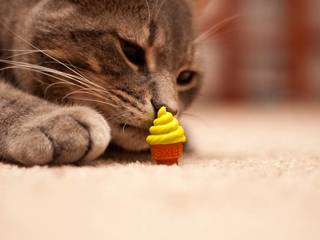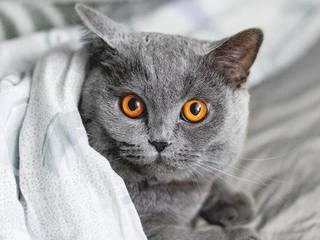A cat's life cycle is a series of stages that the cat goes through as it grows and develops. In the early stages of life, a kitten is born with closed eyes and ears folded back.
The kitten will grow and expand rapidly, and by the time it is three or four months old, it will be able to move around and explore its surroundings. As the cat ages, it will undergo further stages of development, including reaching maturity and becoming an adult.
Introduction
The life cycle of cats is a series of stages a cat goes through as it grows and develops. These stages include the kitten stage, adulthood, and old age—the life cycle of cats' stages of development. A cat's life cycle is a series of steps that the cat goes through as it grows and develops.
In the early stages of life, a kitten is born with closed eyes and ears folded back. The kitten will grow quite rapidly, and by the time it is three or four months old, it will be able to move around and explore its surroundings.
As the cat ages, it will undergo further stages of development, including reaching maturity and becoming an adult introduction. The life cycle of cats is a series of steps a cat goes through as it grows and develops. These stages include the kitten stage, adulthood, and old age.
Birth and early development
The birth and early development of cats is a fascinating process. Cats are born blind, deaf, and without teeth. They are also tiny and fragile. Kittens increase, however, and within a few weeks, they can see, hear, and walk. They are usually weaned and ready to leave their mother by six weeks old.
Cats are born after a gestation period of approximately 65 days. Kittens are held in a sac called the amnion, which protects them from the outside world. The sac is broken open by the mother soon after birth.

Kittens are born blind and deaf. Their eyes open at around two weeks old, but their vision is not fully developed until around four weeks old. Their sense of hearing also develops during this time. Kittens begin to walk at around three weeks old but are not fully coordinated until about six weeks old.
Kittens are born without teeth. Their permanent teeth begin to come in at around six weeks old. Kittens overgrow during their first few weeks of life. They double their birth weight by one week old and triple it by two weeks old. They are usually weaned and ready to leave their mother by six weeks old.
The kitten stage
The kitten stage is the period between a kitten's birth and full sexual maturity. During this time, kittens grow both physically and mentally. This period is a critical time for socialization, and kittens need to have positive experiences with people and other animals during this period.
The kitten stage is the earliest stage of a cat's life, lasting from birth to around six months. During this time, kittens learn to walk, run, and play. They are also overgrowing, gaining weight, and becoming more muscular. Kittens are curious and playful, and they enjoy exploring their surroundings.
They need plenty of calories and nutrients to support their growth, so feeding them high-quality kitten food is essential. Kittens also need plenty of exercises to help them develop strong muscles and bones. Playing with them regularly will help them stay active and healthy.
The average cat litter size is four kittens, but six or more litters are common. Kittens are born blind and deaf and utterly dependent on their mother for food and warmth. Their eyes and ears will open within a week or so, and they will start to explore their surroundings.
Kittens learn to use the litter box and eat solid food during their first few weeks. They also begin to play at this time and will continue to play throughout their lives. Kittens are very active and playful, and they are also very curious. This can sometimes lead them into trouble, so it is essential to kitten-proof your home and keep dangerous objects out of reach.
Kittens will continue to grow and develop until they are around one year old. At this point, they are considered adults, although they may not be fully mature sexually or mentally. Most cats will reach their full adult size in around two years.
The kitten stage is a special and memorable time for both cats and their owners. It is a time of rapid growth and change and a time to enjoy all the little things that kittens do.
Adolescence
Adolescence is the second stage of a cat's life, lasting around six months to two years. During this time, cats continue to grow and mature physically. They also begin to develop their adult personalities. Some cats may become more independent and aloof, while others may remain more affectionate and attached to their owners.
Cats continue to grow and develop at a slower pace than during their time as young kittens. They also begin to build their unique personality. Adolescence is a good time to teach your cat basic obedience commands like sit, stay, come, and down. During this stage, cats experience significant physical and behavioral changes. They undergo a growth spurt and may become lankier as they gain muscle mass and bone density.
Their energy levels increase, and they may become more active and playful. Some cats may also experience an increase in territorial behavior and may be more likely to mark their territory or engage in play aggression.
It's important to provide adolescent cats with plenty of opportunities for play and exercise to help them channel their energy in a positive way. This can include providing them with toys, scratching posts, and climbing structures, as well as engaging them in interactive play.
In addition to physical changes, adolescent cats also experience hormonal changes as they reach sexual maturity. This can lead to behaviors such as spraying or yowling, particularly in unneutered males. In order to prevent unwanted behaviors, it's recommended to spay or neuter cats before they reach sexual maturity.
Overall, the adolescent stage is a critical period in a cat's development that requires attention and care from its caregivers. With proper socialization, training, and care, adolescent cats can develop into well-adjusted, healthy adult cats.
Adulthood
At this stage of development, cats have finished growing, and their bodies have reached their full size and weight. However, just like humans, cats can continue to develop and mature both physically and mentally throughout their adult lives. They also continue to develop their personalities, and their behavior may change depending on their environment and the people around them.
This is the prime of a cat's life. They'll be full of energy and stamina and enjoy playing, hunting, and socializing. This is also when they'll be at their healthiest, so taking good care of them is essential during this stage. They also become more independent and may not want to spend as much time with you as they did when they were younger. However, they still need plenty of exercise and a nutritious diet to stay healthy and happy.
Here are some things to know about cats in their adult stage of development:
Physical Appearance
Adult cats have reached their full size and weight, and their physical appearance is relatively stable. However, their coat may change in color or texture over time. It is important to watch for other changes in their physical appearance during this time because as cats age, they become more susceptible to various health concerns. Sudden weight loss or weight gain is not a normal part of the adult stage for cats, so if you notice anything like this, it will be important to consult with a vet.
Energy Levels
Adult cats tend to be less active and playful than kittens, but they still have plenty of energy. They may spend more time sleeping or lounging, but they still need regular exercise and playtime. The ideal playtime for adult cats can vary based on factors such as their age, health, and personality, but generally, it's recommended to have at least two play sessions per day that last around 10-15 minutes each.
Cats are natural predators, and playtime helps satisfy their instinct to hunt and chase. Regular playtime can also help prevent boredom, reduce stress, and provide valuable exercise, which can help maintain a healthy weight and prevent health issues.
When playing with your cat, it's important to use interactive toys that allow your cat to engage in natural behaviors such as pouncing, chasing, and batting. Toys such as wand toys, toy mice, and balls are great options. You can also try hiding treats around the house or providing puzzle toys to keep your cat mentally stimulated.
Behavior
Adult cats tend to be more independent and less needy than kittens. They may be more aloof and less likely to seek attention, but they still enjoy social interaction with their owners and other pets. Other behaviors you may notice changes within an adult cat include play, increased hiding, increased vocalization, and increased need for affection. Adult cats may not be as playful as kittens, but they still enjoy playtime. Playing with your cat can provide mental and physical stimulation, strengthen your bond, and help prevent behavioral problems.
For example, cats are natural predators, and adult cats may choose to hide in quiet, cozy spots around the house to observe their surroundings or take a nap. Providing your cat with hiding places, such as a covered bed or box, can help them feel safe and secure.
Additionally, Adult cats may communicate through a variety of vocalizations, including meows, purrs, growls, and hisses. They may use vocalizations to express their needs, communicate with other cats, or signal their mood.
While cats are often stereotyped as aloof, many adult cats enjoy affection from their owners. They may choose to sit in your lap, rub against your legs, or purr in response to your attention.
Health
Adult cats require regular veterinary checkups and preventive care to maintain their health. They may be more prone to certain health issues, such as dental problems, obesity, or arthritis, as they age. Dental health is an important concern for cats, and regular dental checkups and cleanings can help prevent dental disease. Feeding your cat a high-quality diet, providing dental chews or toys, and regular tooth brushing can also help prevent dental issues.
Obesity is a common problem in cats, and it can lead to a range of health problems, such as diabetes and joint pain. Feeding your cat a balanced diet, monitoring their food intake, and providing regular exercise can help prevent obesity. Arthritis is a common problem in older cats, and it can lead to pain and mobility issues. Providing soft, comfortable bedding and a low-sided litter box, as well as regular exercise, can help prevent or manage arthritis in cats.
Overall, the adult stage of development is an important time in a cat's life. It's a time when they settle into their adult personalities and develop a deeper bond with their owners.
Senior years
The senior years are a particular time in a cat's life. At this stage in their lives, cats are typically mellower and less active than they were in their younger years. They may not be as quick to jump and run around, but they still enjoy a good cuddle and a nap in the sun.
As cats age, they may start to experience some health issues. This is why taking your senior cat to the vet for regular checkups is essential. Some common health problems in senior cats include arthritis, kidney disease, and cancer.
Giving your old cat plenty of love and attention is also essential. They may not be as playful as they used to be, but they still appreciate being around their humans. Spend some extra time petting and grooming your senior cat, and give them a comfy spot to sleep.
Your senior cat can enjoy a happy and healthy retirement with proper care. Give them lots of love, and they'll return the favor. As our cats get older, they go through a lot of changes. Their physical appearance changes, they become less active, and they may even develop health problems.
It's essential to be aware of these changes so that we can provide the best possible care for our senior cats. One of the most noticeable changes in senior cats is their physical appearance. They may start to lose muscle mass and become thinner. Their coat may become dull and dry. And their eyes may become cloudy or watery.
As cats age, they become less active. They sleep more and don't move around as much. This is normal, and it's nothing to be concerned about. However, if your cat suddenly becomes inactive or starts to sleep all the time, it could be a sign of a health problem, and you should take them to the vet. It's essential to continue to take good care of them during this stage, as they may be more susceptible to health problems.
Senior cats are also more prone to health problems than younger cats. They may develop kidney disease, diabetes, cancer, worsening arthritis, various cancers, and other conditions. If you notice any changes in your cat's health, such as weight loss, vomiting, diarrhea, lethargy, or changes in appetite, be sure to take them to the vet. Kidney disease is another common problem in older cats. Symptoms include increased thirst and urination, weight loss, and vomiting. Older cats are also more susceptible to certain types of cancer, such as lymphoma and squamous cell carcinoma.
Caring for a senior cat can be challenging, but it's also advantageous. They may need more care and attention than they did when they were younger, but they will still bring joy to your life.
Senior cats are the perfect companions for those who want a relaxed and low-key pet. They are typically very affectionate and love to cuddle. They also tend to be less active and don't require as much exercise.
A nutritious diet and regular exercise are still important for senior cats. Additionally, regular vet checkups are essential to help identify any health problems that may arise. Early detection and treatment can often help manage or even reverse many health problems in senior cats.
The benefits of each stage
The different stages in a cat's life come with other benefits. For example, kittens are more energetic and playful, while senior cats are calmer and more relaxed. Each stage has unique benefits that make owning a cat a rewarding experience.
Kittens are full of energy and love to play. They are also very curious and like to explore their surroundings. This can sometimes lead to them getting into trouble, but it's all part of the fun of owning a kitten. As they grow older, they will start calming down and becoming more relaxed.
Adult cats are relatively low maintenance. They don't require as much attention as kittens but enjoy spending time with their humans. They are also usually more independent and don't need as much supervision.
Senior cats are the perfect companions for those who want a relaxed and low-key pet. They are typically very affectionate and love to cuddle. They also tend to be less active and don't require as much exercise.
The benefits of the senior stage, the fourth and final stage of a cat's life cycle, include wisdom and experience. Senior cats typically range in age from 8 to 10 years old. During this time, they may slow down physically, but they can still enjoy a good quality of life.
The importance of providing for a cat's needs at each stage of its life
As cats enter adolescence (around 6-12 months), they become more independent. They may become less interested in playing and more interested in sleeping. Adolescent cats must also be spayed or neutered to help prevent unwanted pregnancies.
Once cats reach adulthood (around 1-3 years of age), they become more settled, and their personalities emerge. Adult cats still need a nutritious diet and regular veterinary checkups, but they usually don't need as much attention as they did when they were younger.
They slow down as cats enter their senior years (around 7-10). They may sleep more and be less interested in playing or being active. Senior cats may also experience age-related health problems like arthritis or kidney disease. It's essential to keep a close eye on your old cat's health and to take them to the vet for regular checkups.
Cats are one of the most popular pets in the world, and it's easy to see why. They're cute, cuddly, and have a lot of personalities. But like any pet, they require care and attention throughout their lives. This blog post will focus on the different stages of a cat's life and its needs at each location.
Conclusion
The life cycle of cats typically consists of four stages: the kitten stage adolescence, adulthood, and old age. Each step brings different challenges and opportunities for the cat, and understanding your cat's needs at each stage can help you give them the best possible life.
The kitten stage is the first stage of a cat's life and lasts from birth until around six months of age. During this time, kittens are learning about the world and growing significantly. They need plenty of proper nutrition, socialization, and play to help them develop into healthy, well-adjusted adults.
Adolescence is the second stage of a cat's life and typically lasts six months to 2 years. During this time, cats can be challenging as they learn to assert independence. Adolescents need patience, love, and understanding to help them through this challenging stage.
Adulthood is the third stage of a cat's life and typically lasts from around two years to 8 years of age. Adult cats are generally more settled and accessible to live with than adolescents but still need plenty of love and care. And last but certainly not least, is old age and retirement!
FAQ
How long can cats stay alive?
The lifespan of a domestic cat can vary greatly depending on factors such as breed, genetics, diet, and overall health. On average, domestic cats live for around 12-15 years. However, some cats can live into their late teens or early twenties, especially with proper care and a healthy lifestyle.
Indoor cats tend to live longer than outdoor cats, as they are less exposed to accidents, predators, and diseases. With advancements in veterinary medicine and improved understanding of feline health, it's not uncommon for well-cared-for indoor cats to live 18-20 years or more.
Which cat lives the shortest?
The cat breed with the shortest lifespan is difficult to pinpoint, as the lifespan of a cat can be influenced by various factors, such as genetics, health, diet, and environmental conditions. However, some cat breeds may be more prone to certain health issues or have genetic predispositions that could potentially shorten their lifespans.
For example, the Manx cat, a breed known for its lack of a tail or having a very short tail, can suffer from a condition called Manx Syndrome. This is a genetic disorder that affects the spine and can lead to various health problems, potentially shortening the cat's lifespan.
Another example is the flat-faced, or brachycephalic, breeds like the Persian or Exotic Shorthair. These breeds can be more prone to respiratory issues, dental problems, and eye conditions due to their facial structure, which could impact their overall health and longevity.
Why do cats have 9 lives?
The saying that cats have nine lives is a myth and not based on any scientific fact. This popular myth likely stems from the cat's agility, flexibility, and ability to survive falls from heights with relatively little injury, which gives them the appearance of being able to escape death multiple times.
The origin of the belief that cats have nine lives is not entirely clear, but it can be traced back to ancient times. In some cultures, the number nine is considered magical or lucky, and this could have contributed to the association with cats. For example, in ancient Egypt, cats were revered and considered sacred, and the number nine held significance in their mythology. In ancient Greece, the number nine was associated with the nine Muses, who were considered goddesses of inspiration.
What are cat lives in human years?
Converting cat years to human years is not as straightforward as a one-to-one ratio, as cats age differently than humans. The first two years of a cat's life are equivalent to roughly 25 human years, and after that, each additional cat year is approximately equal to 4 human years.
Here's a rough guide to converting cat years to human years:
1 cat year: ~15 human years
2 cat years: ~25 human years
3 cat years: ~29 human years
4 cat years: ~33 human years
5 cat years: ~37 human years
6 cat years: ~41 human years
7 cat years: ~45 human years
8 cat years: ~49 human years
9 cat years: ~53 human years
10 cat years: ~57 human years






